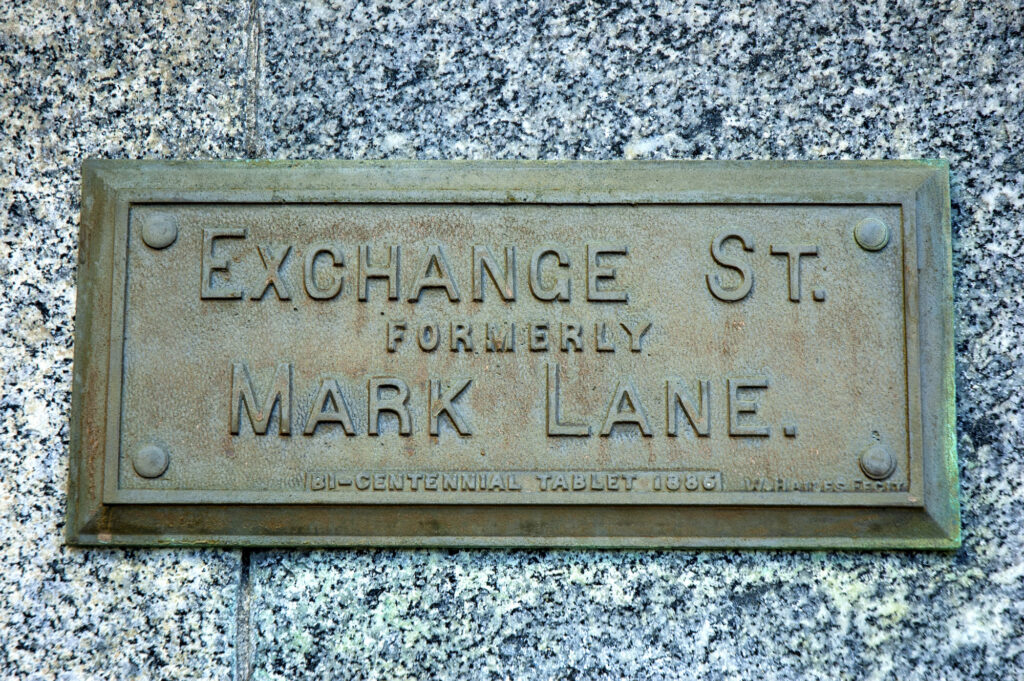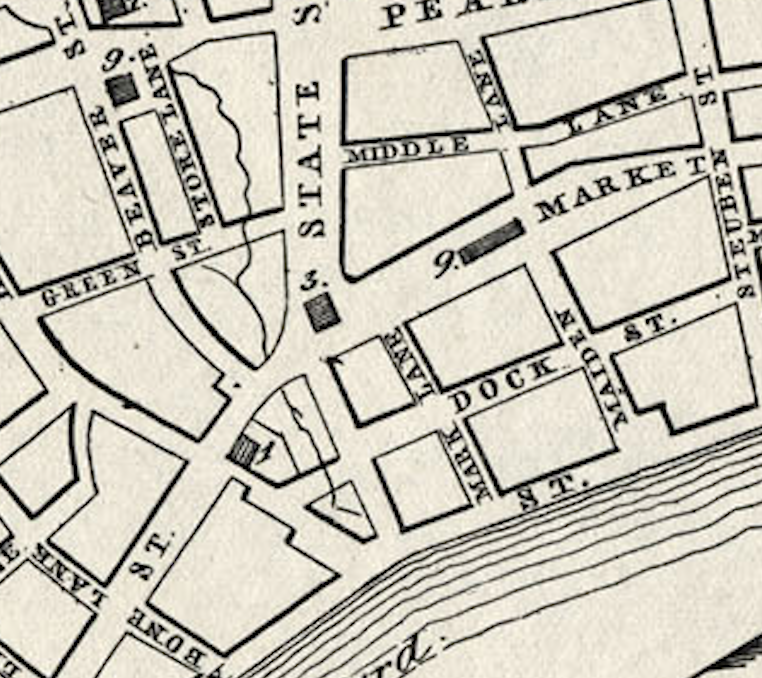Here’s another Albany Bicentennial marker that commemorated a street that today we barely know exists. The extent of the copy was always very limited, as described by the Bicentennial Committee back in 1886:
Bronze tablet, 7×16 inches, north side of Government building. Inscription: “Exchange Street, formerly Mark Lane.”

We’ve found no source that explains why it was called Mark Lane. By either name, the street was never more than a stub, and a somewhat broken one at that, running between Broadway and Quay:

The Albany Atlas wrote in 1853 about the Exchange Building, which was bounded on the north side by Exchange Street, with Broadway to the west, State to the south, and Dean to the east. The building then contained the Post Office, the Exchange Bank, and other offices. That was replaced (1879-83) by what is now the old Old Post Office and Federal Building, which still stands at the foot of State Street and is part of the SUNY Central Administration complex at The Plaza.
The Albany Exchange Bank was authorized by the State Legislature in 1838, and organized under articles of association commencing January 1, 1839 (with a termination date of January 1, 2500, which was certainly forward-looking). It was authorized for general banking purposes and, like most banks of the day, issued its own banknotes, which are collectible to this day. In the 1857 city directory, banknote engraver Joseph Gavit is listed as doing business on the second floor of the Exchange Building, which would certainly have been convenient. The building also housed notaries, insurance agents, express agents, accountants and attorneys.
The Albany Exchange Bank later also went by the name of National Albany Exchange Bank, and appears to have had an affiliated Albany Exchange Savings Bank.
We haven’t found the details on the original Exchange Building that housed the bank and so many others, but the Albany Institute has preserved a lovely 1846 lithograph showing it (on the right). Of course, in this view, Exchange Street isn’t really visible – it’s just the little gap between the Exchange Building and the highly distinctive second building of the Mechanics and Farmers Bank, which later moved across the street and, later still, was located in the distinctive building that still stands at State and James.

This 1846 lithograph by Benjamin F. Smith, Jr. (and printed by Pease’s Establishment) shows the Albany Exchange building at the right, with clear signs of the Exchange Bank, Exchange Office (if that was something different), fur manufacturers Taaffe and Gough, and the Livingston, Wells & Co. Express office (forerunner of American Express, and of Wells Fargo).
The street was still called Mark Lane in 1836, when coffee and spice merchant G.I. Crocker was advertising his wares at No. 7 Mark Lane in the Albany Evening Journal. The foot of Mark Lane was also the office of an Erie Canal transportation line, which around this time, 1833, advertised that its horses would no longer ride with the passengers.
But we also find an ad from 1836 from Froment & Co., also a coffee and spice merchant with an address of 9 Exchange street, “formerly Mark lane.” So this would appear to be about the time that the name changed. In April it was just Mark Lane, in May it was formerly Mark Lane. The name change would appear to precede the formation of the Exchange Bank – so whether one name affected the other, or whether “exchange” just reflected the numerous businesses in the immediate area, is hard to say. There was also an Exchange Hotel to be found in the 1865 directory, located at Maiden Lane and Broadway (not Exchange Street).

According to Joel Munsell’s Annals of Albany, the first curb stones in Albany were introduced in 1824 through the perseverance of alderman John Maley Cuyler, and they were installed along North Market Street (Broadway) from Maiden Lane to Mark Lane.
Similar to Dean Street, why the Bicentennial committee thought Exchange Street was worthy of a commemorative marker is a bit of a mystery – but without that marker, the name of the street might have been entirely forgotten.

Leave a Reply